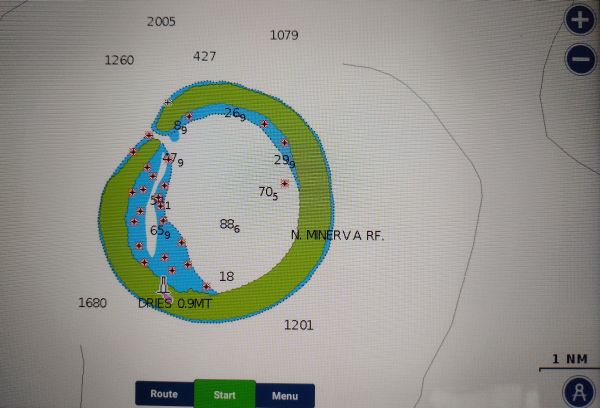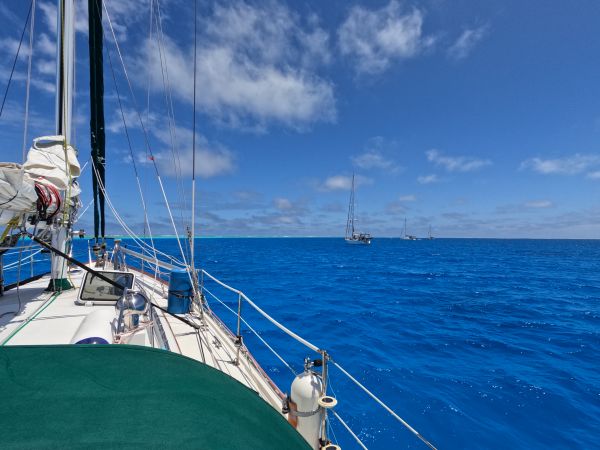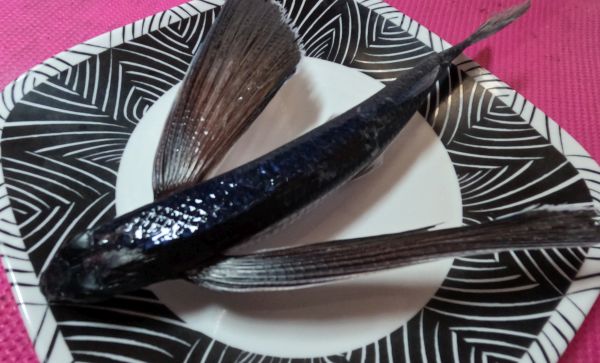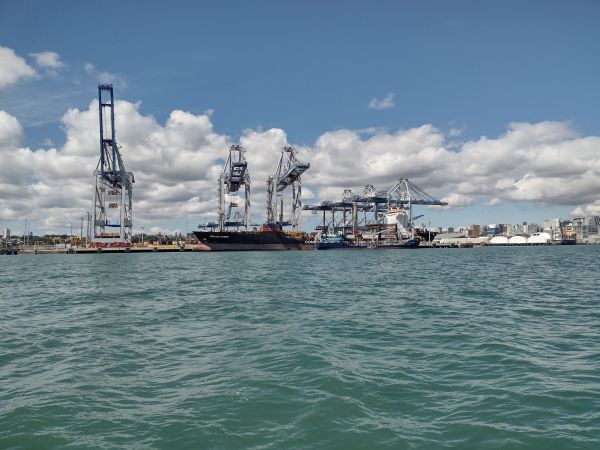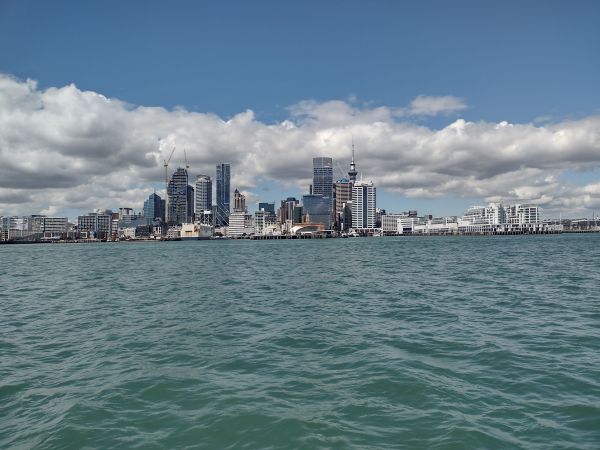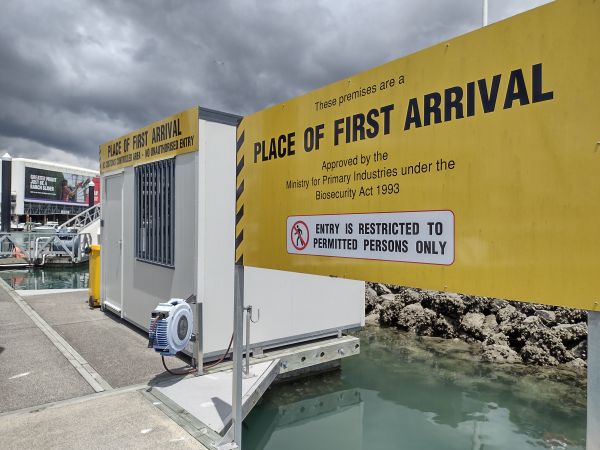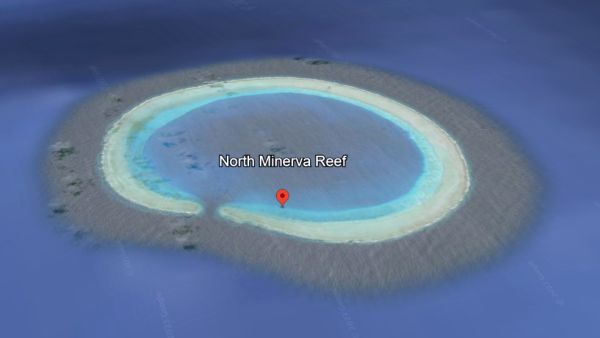
(October 20 to November 10, 2023, Total 21 minus1 Days at Sea) We checked out American Samoa on the 19th. We have 24 hours to depart the island. The weather is not ideal for sailing but we decided to take a chance because we didn’t want to deal with the schedule change with New Zealand, especially with our cat import related.
Crossing the International Date Line (180o Line) – We lost one day.
We sailed about 747 nms from Pago Pago to Minerva Reef, close to Tonga. We averaged 150 nms/day and took five days to Minerva Reef. According to the calendar, we arrived six days after our departure. There is one day time difference between American Samoa (GMT -12 Time Zone) and Samoa/Tonga/Minerva Reef/New Zealand (GMT +12 Time Zone). Conveniently, we didn’t have to change time on our watches nor a clock.
For this five day sailing, I had the most fearful and the most beautiful sailing moment. We also motored for 15 hours due to the lack of the winds. Cats don’t eat much when it is rough or when we run the engine. They usually get dry food. Knowing they were not eating much during this trip, I gave them spare wet food and treats. They liked it.
Our wind meter died in American Samoa. It showed the direction of the wind but not speed. We figured out the wind speed by observation and feel. At night, we reduced the main sail to the second reef. Boat was still heeling too much. When walking on the boat, I had to lean my body about 45 degree angle to the side, holding the rails all the time. Cats did the same thing but without holding anything. They have four legs.
Power of waves hitting the side of the boat was fearful. It scared me and cats but John. The boat port lights (windows) were well sealed and protected. However, one of them showed a minor water leak as the wave hit hard on it. Changing our watch schedule, I told John “Pray to God!” He said for what? I said, “Not to sink.” He responded that the worst thing is “Boat gets a fire” and added “God helps those who help themselves. Nothing is going to happen. Valiant (Bad Bunny Maker) is a strongly built ocean cruising boat.”
Navigation
For the navigation, we are heavily relying on “Navionics Electronic Charts” on John’s iPad. We have secondary old Garmin GPS but the charts on this device are not as detailed as Navionics. We also have three South Pacific cruising books with local charts. At some point in American Samoa, I realized that we have to solely rely on John’s iPad for sailing to New Zealand. I was not comfortable with that situation. It would be nice to have some sort of paper chart or secondary chart. Concerning the only one chart to New Zealand, I purchased and downloaded a one year subscription of maps from Navionics for New Zealand/Australia and South Pacific Regions.
Deleted Navionics Electronic Charts
Big oops! Having more free time at sea, John decided to organize and clean the data on his iPad. While doing it, by a mistake, he deleted the Navionics app and all of the charts were gone with one touch. OMG! He was dumb-found. I couldn’t believe what happened. I was somewhat relieved that I downloaded charts to my android device, one day before our departure. My device doesn’t have a waterproof case and is not as strongly built as the iPad. From this point, we treated my android tablet as God. This is the only detailed chart we can guide ourselves to New Zealand.
Weather Update via IridiumGo
For the weather update, we downloaded Grib files via IridiumGo satellite device. There was a possible cyclone developing near the Vanuatu and Fiji area. We were impacted by the strong winds from it. Winds got stronger. Boat heeled too much, sometimes turning the high-water bilge pump on. We reduced our sails to a smaller size.
Going away from the equator, we were getting cooler. It is time for long pants and long sleeves since leaving Ensenada, Mexico in April. When John was in bed, he used his electric blanket and cats loved it.
At North Minerva Reef
I say Minerva Reefs are like an “Oasis at Sea”. There are North Minerva and South Minerva reefs. It has no land or fresh water. When tides are low, as water goes down, the reef appears. Otherwise, the reefs are under the shallow water, looking like a continuation of the ocean. Inside the reef, there are spots with 40 to 50 feet depth sand bottom where sailors anchor their boat. It is a good place to refresh and wait for a suitable weather window for the next destination.
North Minerva Reef is circular in shape, diameter about 3 miles with an entrance, about 0.2 miles wide. For my last nine years of sailing around the world, I have great memories. The memory of Minerva Reef for me is one of the best moments. How cool is it that you are in the middle of the South Pacific water and anchored there, feeling comfortable being at home!
We didn’t explore the Minerva Reef but just enjoyed being there. It was quiet and calm with cool temperature about 73 to 68 Fahrenheit (about 23 to 20 Celsius) with water temp 74-76f (23-24c). For the last two months, I was having some skin issues on my feet and hands after snorkeling in French Polynesia. It was better to keep them dry by not visiting the watery reef. Our plan was staying in Minerva Reef for four nights but extended to six nights as we had some boat issues to resolve.
Cooking and Cleaning
Minerva anchorage was peaceful. I cooked many dishes to use up the ingredients on the boat. Otherwise, we have to trash those that New Zealand doesn’t allow visitors to bring in. Before departure, we read the food regulations on the New Zealand Biosecurity website. We made sure we are compliant. No nuts allowed unless they are in an unopened manufactured original package and not whole nuts. I used all the leftover nuts with maple syrup and caramelized them with cinnamon. I kept a bag of half-shelved Pecan nuts unopened in an original bag. Whole beans are not allowed. I used them for making fried rice with lots of leftover bacon bits and chili cranberries (from CostCo in Mexico) with lots of sesame seeds. I made pasta with nuts, sun-dried tomatoes, and etc. Cole-slaw, Couscous, all leftover mixed soup, freshly baked bread… I became a super efficient cook. No chocolates with any fruits. No fruit jam/jelly, no peanut butter. We finished honey a while ago so not to worry about it. John indulged in all the sweet goodies.
I cleaned shoes, hiking poles and checked my tent to not leave any dirt. I even used q-tips to clean the bottom of the shoes. John was busy fixing the reefing lines inside the boom, repairing two toilets which certainly stopped working one by one. He SCUBA dove to check and clean the boat bottom and the propeller and shaft not to have any barnacles on. New Zealand Biosecurity has strict regulation on this. We videotaped the spotless boat bottom and printed some pictures of it, in case the New Zealand Biosecurity asks for it.
Sailing to Auckland, New Zealand (1,108 nms from North Minerva Reef, November 1 to 10, 2023)
On November 1st, we left Minerva Reef for New Zealand. The weather was not favorable. I wanted to stay longer in the Minerva Reef but we need to arrive in a certain timeframe that we previously wrote as November 8th on the Customs forms. Wind direction was difficult to sail. For the next sailing, we had to tack and gibe (zig-zag sailing) to get close to New Zealand.
Winds were strong from a not favorable direction. We decided to lower the mainsail. Waves kept hitting the boat hard. When we worked on the sails on the deck, we wore harnesses. Without it, we could be thrown out to the sea. Our gear and lines remained wet as waves kept pouring sea water on the deck. I gave up keeping my troubled feet and hands dry. No way!!! We left all the wet gear in the cockpit. Cats stayed on the electric blanket inside with unhappy faces, due to the banging sound by the waves.
Auto-pilot Issue
Our proud auto-pilot certainly stopped working when the sea was very rough. John was not confident in the repair of it. He also mentioned that hand-steering in this high wave and to head-wind direction is not an option. I started to worry seriously. I certainly realized that we may not have enough food for a longer journey.
I usually carry three times more food when we sail, in case for an emergency. This time, we kept the minimum food amount on the boat so as not to have any issues with the New Zealand Biosecurity and not to waste our food. I felt better knowing that we have 40 packages of Mexican refried beans. Leaving Mexico in April, I bought a lot because it is easy to eat directly from the package. Good nutrition, high-energy, well packaged. It is also useful to block the rattling sound inside of the kitchen cabinet doors by boat movement. No problem. We have enough food. We can catch fish also. What about fuel to run the generator? Do we have enough fuel to run the boat for a long time? We must fix this auto-pilot. After troubleshooting and lastly replacing the auto-pilot RAM, we thanked and thanked for the fix. We gave each other a high five.
Personal Distress Beacon
While repairing the auto-pilot, we heard an alert alarm on our AIS (Automatic Identification System). After checking the display, we found it was activated from our personal distress beacon which John bought and installed on our harness after having his MOB incident in the Sea of Cortez, Mexico. “This beacon is used to alert vessels equipped with AIS receivers located nearby, as well as all vessels equipped with a VHF equipped with the DSC (Digital Selective Calling)”. The main reason John installed is to alarm ourselves in case one got overboard when the other is inside sleeping. We didn’t activate this device. It was a false alarm so we deactivated it. However, it kept activating itself. Unable to deactivate it, we wrapped the beacon with lots of towels, kept it in a small container, and wrapped the container with towels to reduce the alarm sound.
Next day, I noticed that there was a “Man over Board (MOB)” GPS mark on my device. The day before, during rough weather sailing, we spoke to a lady on the VHF radio. She is a solo sailor who previously sailed around the world. We were concerned if the alarm was initiated by her. It was about 8 hours reverse sailing distance to the position if we decided to rescue the person, whoever he/she might be. John and I discussed and agreed not to go reverse because “(1) the survival rate is low as water is cold and it happened a long time ago and (2) it is too risky for us to reverse sailing to the position. Our decision wasn’t easy so I tried to get details of the location mark.
Each boat and AIS Beacon has an MMSI (Maritime Mobile Service Identity). By writing the MMSI number from the alarmed position and checking our AIS distress beacon, I found the alert position was marked by our AIS when it was falsely activated. We felt much better. We wondered if this device actually can save the boaters. We heard no one calling on VHF radio when the distress alarm first ran off.
Funny thing is that, the second beacon started alarming days after we docked in a marina in Auckland. The device was still wet because of frequent rain. It shouldn’t activate the device unless a person pulls the cover. We tried to deactivate but it periodically kept activating itself. After many days in the marina, one of the marina employees came to us asking about MOB alarms. He is the first person who asked about the distress alarm. We explained to him what happened. John contacted the company and was asked to send them back to them. It involves international shipping, lithium-ion battery shipping issues, occasional possible alarm sound during shipping if the battery is still alive. We are waiting for an email reply from the seller to resolve this matter.
IridiumGo Device
We use IridiumGo mainly for the weather update. I periodically sent and received text messages via this device. It worked well for the first five days for me. However, I didn’t get any messages later on. After arrival, I found my families were not able to reply to my messages. This is a slow speed device. Maybe an image or photo was blocking my text message transmission? I checked my IridiumGo account on the internet but there are no archived messages etc so I wouldn’t know what messages were missing delivered, if any.
Communication with New Zealand Officers
It is important to inform New Zealand Customs, Biosecurity, and Pet Quarantine facility to inform our delays and actual 24 hour prior to arrival time. We emailed them for our two-day delay and 24 hour prior arrival notice. For the last sailing day, we motored for the full day to arrive on time. Otherwise, if we had to zig-zag sailing with head-wind, we would definitely arrive not as scheduled.
Most of the international cruisers arrive in Opua, northern part of New Zealand. We chose to arrive in Auckland because the quarantine facility for our cats is in Auckland. We didn’t want cats to be transported by a car for another 4 hours after being at sea for 21 days, not to mention the pickup and roundtrip transportation cost.
Approaching the Customs dock, we felt warm sunshine. It was a little confusing where the customs dock is; despite we studied the location prior to our departure. We managed to dock at the Customs Dock with the help from the Westhaven Marina employee. Later, two Biosecurity officials thoroughly inspected our boat and trashed a can of Campbell’s Chunky Soup because it has a little bit of pork sausage in it. John would have eaten it if he read the ingredients. We had to give up two bear spray cans which we kept on the boat for security reasons at sea. The Biosecurity officers pitched them. We got our passport stamped by the customs/immigration officer. Later, the driver from the animal quarantine facility picked-up our cats and we received the “Full Clearance Document” from Customs/Biosecurity. Welcome to New Zealand!
